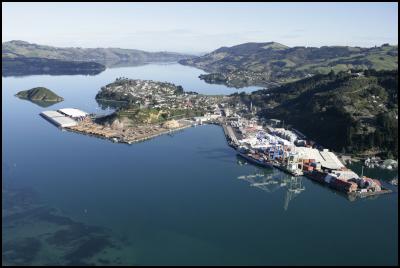Port Otago first to secure consents for channel deepening
Media
Release – 12 December 2012
Port Otago
first to secure consents for channel
deepening
Environment Court
Judge Jeff Smith has granted Port Otago’s application to
deepen its Otago Harbour channel in anticipation of the
arrival of bigger container ships on the New Zealand
coast.
The company had originally sought consent from the
Otago Regional Council for resource consent to:
• Deepen, widen, and maintain the lower harbour
channel; the swing area and Port Chalmers berths; and to
allow the passage of larger ships to Port Chalmers;
• dispose of the dredge spoil to sea,
and;
• extend the multi-purpose wharf and to construct
a new fishing jetty at Port Chalmers.

The court’s decision means Port Otago is the first port company in the country to achieve the milestone of a fully-consented project to deepen its channel.
Company chairman Dave Faulkner said this was a landmark decision.
“It is as historically significant for the company as our first frozen meat export on the SS Dunedin in 1882, or the opening of the Port Chalmers container terminal in 1977,” Mr Faulkner said.
The consents are for a 25-year period and allow the company to deepen the Port Chalmers channel to 15 metres. Port Chalmers is already the country’s deepest container port at 13 metres. Having the ability to increase this to 15 metres means that Port Otago’s board and management could respond rapidly to changing shipping needs whenever they arose, Mr Faulkner said.
Once the deepening project is completed, Port Chalmers will have the capability to receive calls from container ships carrying up to 8,000 TEU (20 foot equivalent containers).
“Our project will have real benefits for South Island shippers, as Port Otago’s ability to accommodate larger vessels will ensure that exporters and importers are not penalised by increased costs in their international supply chain, such as additional inland freight or transhipping costs,” he said.
Port Otago plans to complete the dredging programme in several stages, depending on commercial demand. The first stage will be to incrementally deepen the existing channel to 14 metres.
The company has the added advantage of owning its own dredging fleet, so the first stage can be done at any time and, with more than 50% of the existing channel already at 14 metres, the cost of completing the first stage is projected to be between $5 million and $10 million. This is substantially cheaper than any other port in the country.
Mr Faulkner said the size of container ships has been steadily increasing as shipping lines endeavour to move freight around the world more efficiently and economically.
Shipping was already the most environmentally friendly method of transporting goods over long distances. Newer, bigger ships provided even greater efficiencies and would further reduce their carbon footprint.
Mr Faulkner said the global trend towards bigger ships has already started to affect New Zealand, with a number of this country’s largest exporters and other interest groups calling for New Zealand ports to prepare themselves ready for larger vessels.
Mr Faulkner said Port Otago was well-positioned for the next generation.
“Our landside infrastructure is modern and in excellent condition, our productivity is the highest of any port in the South Island and, with these consents, we can instantly respond to market demand for larger ship facilities. We have the complete package.”
Ends.


 PSA: PPPs Pose Risks To New Zealand Workers
PSA: PPPs Pose Risks To New Zealand Workers Office of the Privacy Commissioner: New Research Shows Business Leaders Fear Being On The Hook For Others’ Privacy Breaches
Office of the Privacy Commissioner: New Research Shows Business Leaders Fear Being On The Hook For Others’ Privacy Breaches E Tū: E Tū Members Send Open Letter To James Grenon And NZME Board
E Tū: E Tū Members Send Open Letter To James Grenon And NZME Board Commerce Commission: Commission Calls For Comments On Copper Access Deregulation
Commerce Commission: Commission Calls For Comments On Copper Access Deregulation New Zealand Association of Scientists: NZAS Supports Saving Biotechnology Capacity In Callaghan; Asks What Now For Applied Technology Group
New Zealand Association of Scientists: NZAS Supports Saving Biotechnology Capacity In Callaghan; Asks What Now For Applied Technology Group Stats NZ: Business Employment Data - December 2024 Quarter
Stats NZ: Business Employment Data - December 2024 Quarter



